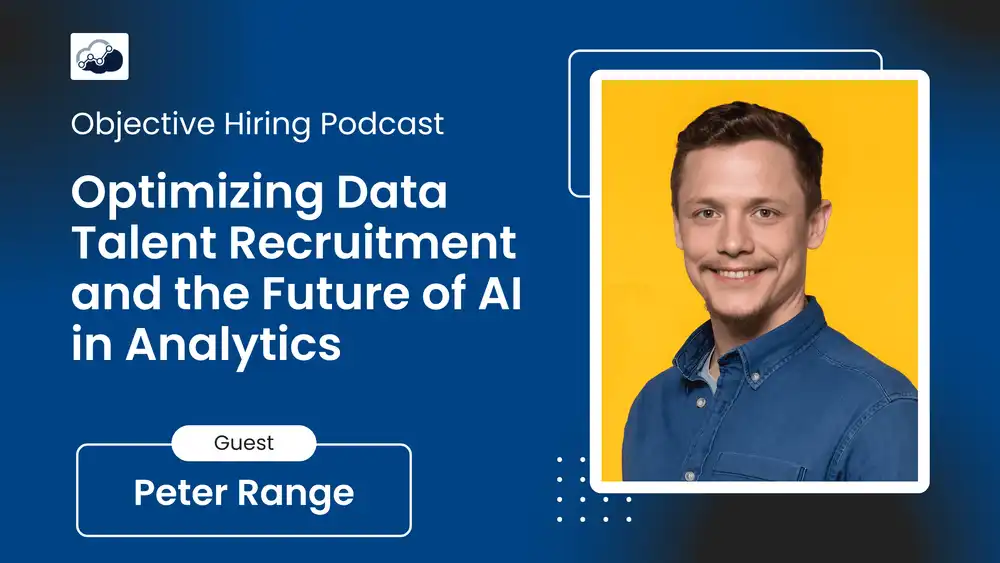Peter Range on Data-Driven Hiring: Why CVs Alone Won’t Cut It

Peter Range on Data-Driven Hiring: Why CVs Alone Won’t Cut It
On a recent episode of the Objective Hiring podcast, hosted by Tim Freestone, we spoke with Peter Range, a seasoned Data & Analytics Leader, about why so many hiring processes fall short—and what to do instead.
The conversation tackled one central issue: companies still rely heavily on CVs to evaluate talent. Peter was candid in his view:
"You can't just read the CVs right; you need to really be making sure that you're putting people through screening processes that can identify talent in hidden places."
Peter’s approach flips the traditional hiring model. Instead of letting resumes dictate which candidates proceed, he starts with technical assessments—objective, measurable, and fair.
"I actually like to not see CVs until we've been through the technical testing... I'd rather be evidence-led off how they perform."
This data-first hiring mindset is core to what platforms like Alooba enable: allowing hiring teams to assess what people can do, not just where they’ve worked.
Cultural Fit: Overused and Undervalued?
One of the most revealing moments in the podcast came when Tim asked Peter about the obsession with "cultural fit" in hiring. Peter acknowledged its importance but warned against over-relying on it:
"You can find a genius who just has horrible cultural fit and rubs everybody up the wrong way. You're not going to be very impactful."
But he also shared a practical way his team evaluates fit:
"We typically do that based on a one-two-three-four scale on values. And we ask everyone to write it down before the more outspoken people declare their opinion."
This avoids groupthink and ensures everyone’s view is captured fairly. It’s a reminder that even subjective qualities can—and should—be structured for consistency.
Measuring What Matters
Peter shared his frustration with hiring decisions based on gut feel or superficial impressions:
"We’ve had people with master's degrees from reputable universities who can't do the basics."
Instead of credentials, Peter focuses on outcomes:
"We've had some amazing talent come through from online data conversion courses."
The key is designing assessments that reflect the actual work and identifying what success looks like in the role—not relying on proxies like university names or previous job titles.
The Cost of Hiring Wrong—or Missing Out
Peter and Tim also explored the rarely discussed concept of false negatives in hiring.
"You never know that hey, it turns out I rejected the next president of the United States... some up-and-coming genius."
Whereas everyone remembers a poor hire (the false positive), few track the amazing candidates who slipped through the cracks. This is where structured assessments shine—giving everyone a fair shot, especially those who don’t look like the “typical” candidate.
"You're looking for things that aren’t priced into the market... and that's where you find alpha."
By being open to undervalued or overlooked candidates, companies can compete on a smarter playing field.
Flipping the Funnel: Why Tests Come First
One of the most practical takeaways from Peter’s process is how he restructured his hiring funnel:
- Talent acquisition screens for logistics (e.g. visa status, salary expectations).
- Candidates then complete a live technical test.
- Only afterwards does Peter review the CV and career history.
"The main reason why we're doing it live is to ensure that there's no kind of copy and pasting of large blocks of code."
The goal isn’t to create pressure—it’s to remove ambiguity. And it ensures the person who performs well actually earns their way through.
Trust Between Talent Acquisition and Hiring Managers
Peter also flagged the need for a strong relationship with the talent team. His model only works if talent acquisition brings candidates worth testing.
"I need to have a lot of trust in my talent acquisition that they're going to give me a group of candidates that aren't going to waste my time."
It’s a reminder that objectivity in hiring doesn’t just come from tech—it also depends on good communication and shared goals.
The Rise of “Moneyball” Hiring
Drawing from the book Moneyball, Peter likens great hiring to exploiting market inefficiencies—finding high-value candidates that others overlook.
"Are you missing out on hidden value?"
Just as sports teams use stats to uncover undervalued players, hiring teams can use skills assessments to uncover undervalued talent.
"If you know what stats and metrics really matter to your job and you can measure them, then you can exploit these market inefficiencies."
In a world of intense competition for data talent, this might be the biggest edge available.
Hiring for the Job You Actually Have
A subtle but powerful insight from Peter was that many hiring mistakes happen when companies try to solve deeper problems with talent alone.
"Too many companies expect talent to be a silver bullet."
Instead of hiring more analysts to fix reporting issues, maybe the problem lies in engineering or governance. A misaligned hiring strategy, he warns, can cost millions without fixing the real issue.
Final Thoughts
Hiring should be a competitive advantage—not a lottery.
Peter’s approach is refreshingly simple: measure what matters, test early, and trust your team. That’s how you find the right people, not just the right CVs.
If you're trying to make your hiring fairer, faster, and more effective, platforms like Alooba can help. By testing skills, not resumes, you’ll uncover the talent others overlook.